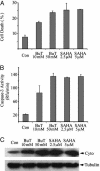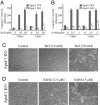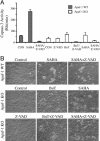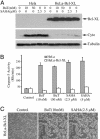Apoptotic and autophagic cell death induced by histone deacetylase inhibitors
- PMID: 15596714
- PMCID: PMC539807
- DOI: 10.1073/pnas.0408345102
Apoptotic and autophagic cell death induced by histone deacetylase inhibitors
Abstract
Histone deacetylase (HDAC) inhibitors can induce programmed cell death in cancer cells, although the underlying mechanism is obscure. In this study, we show that two distinct HDAC inhibitors, butyrate and suberoylanilide hydroxamic acid (SAHA), induced caspase-3 activation and cell death in multiple human cancer cell lines. The activation of caspase-3 was via the mitochondria/cytochrome c-mediated apoptotic pathway because it was abrogated in mouse embryonic fibroblasts with knockout of Apaf-1, the essential mediator of the pathway. Overexpression of Bcl-XL in HeLa cells also blocked caspase activation by the HDAC inhibitors. Nevertheless, Apaf-1 knockout, overexpression of Bcl-XL, and pharmacological inhibition of caspase activity did not prevent SAHA and butyrate-induced cell death. The cells undergoing such caspase-independent death had unambiguous morphological features of autophagic cell death. Therefore, HDAC inhibitors can induce both mitochondria-mediated apoptosis and caspase-independent autophagic cell death. Induction of autophagic cell death by HDAC inhibitors has clear clinical implications in treating cancers with apoptotic defects.
Figures





References
-
- Hanahan, D. & Weinberg, R. A. (2000) Cell 100, 57–70. - PubMed
-
- Johnstone, R. W., Ruefli, A. A. & Lowe, S. W. (2002) Cell 108, 153–164. - PubMed
-
- Thornberry, N. A. & Lazebnik, Y. (1998) Science 281, 1312–1316. - PubMed
-
- Ashkenazi, A. & Dixit, V. M. (1998) Science 281, 1305–1308. - PubMed
-
- Peter, M. E. & Krammer, P. H. (2003) Cell Death Differ. 10, 26–35. - PubMed
Publication types
MeSH terms
Substances
Grants and funding
LinkOut - more resources
Full Text Sources
Research Materials

